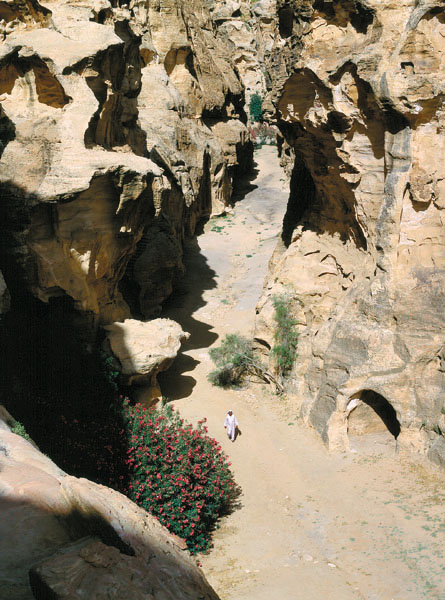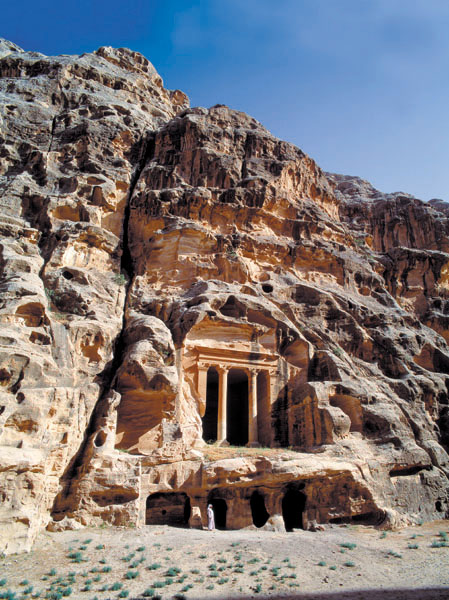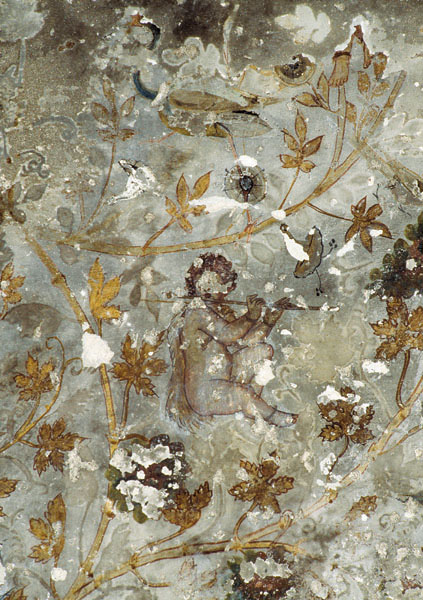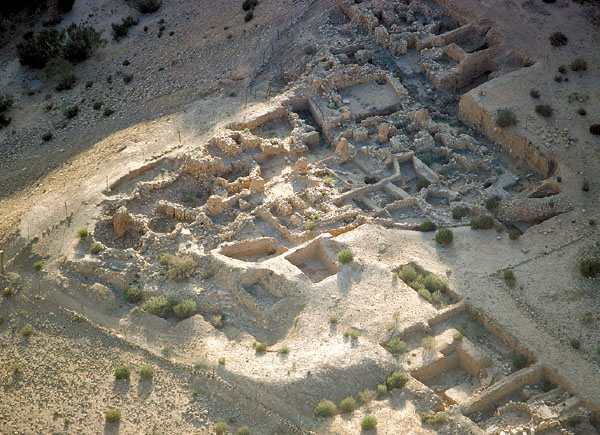
Not far from Petra, southern Jordan’s “rose-red city half as old as Time,” lie two sites that are far too frequently overlooked.
About a half-hour’s drive from Petra is Little Petra (Siq al Barid in Arabic), which, like its more massive namesake, served as a way station for Nabatean incense caravans more than 2,000 years ago. And then, within walking distance of Little Petra, are the ruins of Beidha, where a group of Neolithic hunter-gatherers ceased wandering, settled down and built homes.
Visitors to Little Petra first glimpse an elegant tomb with an urn carved above the building’s triangular pediment. The tomb stands at one end of the narrow defile that provides entry to the site. Like all the rock-cut buildings at Little Petra, it was probably carved between the first century B.C. and the first century A.D.
Traders plying the route between the mountains of south Arabia and the Mediterranean port of Gaza, the gateway to Rome and its empire, rested in Little Petra’s cool gorge while their donkeys and camels remained tethered outside near huge cisterns full of water. (One of those ancient cisterns—still used today by local Bedouin—can be seen at the head of a stairway that comes into view after you turn right off the main road from Petra toward Siq al Barid.)
As you walk through a Y-shaped cleft in the gorge, originally widened to allow laden camels to pass through, you see scores of tombs—each with its own cistern and catchment system—on both sides of the gully. (The high cliff walls funneled rainwater into canals leading to the cisterns.) Virtually every tomb along the right arm of the “Y” has both a cistern and a triclinium, a room lined on three sides with rock-cut benches, where funeral feasts were held. These triclinia are found in greater abundance in Little Petra than they are in “big” Petra.

Little Petra’s most famous landmark is the “Painted Tomb.” After stepping through an unadorned doorway, a two-benched dining hall, or biclinium, comes into view. The ceiling of a nearby alcove is painted with images of a cherubic Eros carrying his bow and arrow, along with a flute-playing Pan cavorting among birds in a leafy bower. This lovely room suggests how the monuments at Petra may once have been decorated.

To continue on to Beidha, you may be able to negotiate with the locals for a ride, but don’t attempt the drive unless you have a four-wheel-drive vehicle. Should you prefer to walk, you’ll reach the fenced, 4-acre site in about 45 minutes.
Beidha lay undisturbed for millennia, its 9,000-year-old homes covered by sand, until British archaeologist Diana Kirkbride discovered the site in 1956 and began excavating two years later. The settlement’s earliest houses were round, their floors set about 20 inches below ground level. Each building, as described by Kirkbride, was “erected around an inner skeleton of posts and beams.” Postholes about 16 inches apart were dug around the floor’s perimeter, and the posts set in them were connected by beams to a strong central post. Stones from nearby mountains and wadis (dry riverbeds) were used to fill the spaces between the perimeter posts. The entire structure was then plastered to stabilize the wall. (In the remains of plaster, Kirkbride found “myriad imprints of the plants people cultivated and collected … tens of thousands of grain imprints”—evidence of barley and wheat cultivation.) According to Kirkbride, the ancient Beidhans laid brush or reeds above the beams to support a thick clay roof.

Over time, as Beidha’s inhabitants became more confident builders, the round walls evolved into straight-sided buildings—“Each of which,” wrote Kirkbride, “comprised a central corridor and six small cubicles arranged three on each side. From the objects found in these cubicles it seems they were workshops.”
The finds from Beidha, some of which can be seen in the Citadel Museum in Amman, Jordan, include finely worked flint tools, which must have been made from imported flint. The Neolithic Beidhans used blades, scrapers and arrowheads as well. There is also evidence of agricultural activity: stone querns (mills used to grind grain), pestles, grinders, polishers, axes or hoes, a large bowl and a whetstone. One basket was found covered with bitumen from the Dead Sea; another was coated with thin lime plaster.
Beidha provides us with a complete record of the early Neolithic period, from about 7000 to 6500 B.C. The settlement remained undisturbed by later occupation, perhaps because the climate in the area grew increasingly arid and inhospitable.
This seemingly mundane achievement at Beidha—the building of a village—may be even more remarkable than the immense, beautiful monuments the Nabateans hewed out of red sandstone cliffs at the Petras.

